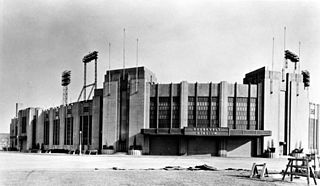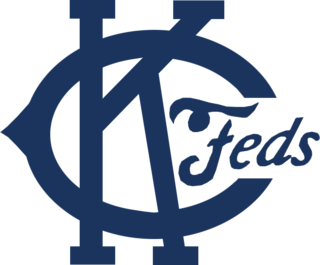
Wrigley Field was a ballpark in Los Angeles, California. It hosted minor league baseball teams in the region for more than 30 years. It was the home park for the minor league Los Angeles Angels during their run in the Pacific Coast League, as well as for the inaugural season of the major league team of the same name in 1961. The park was designed by Zachary Taylor Davis, who had previously designed both of the Major League Baseball stadiums in Chicago: Comiskey Park and Wrigley Field. The ballpark was also used as the backdrop for several Hollywood films about baseball, as well as the 1960 TV series Home Run Derby.

The Polo Grounds was the name of three stadiums in Upper Manhattan, New York City, used mainly for professional baseball and American football from 1880 through 1963. The original Polo Grounds, opened in 1876 and demolished in 1889, was built for the sport of polo. Bound on the south and north by 110th and 112th streets and on the east and west by Fifth and Sixth (Lenox) avenues, just north of Central Park, it was converted to a baseball stadium when leased by the New York Metropolitans in 1880.
Bears & Eagles Riverfront Stadium, originally simply Riverfront Stadium, was a 6,200-seat baseball park in Newark, New Jersey built in 1999. It was the home field of the Newark Bears, who played in the Atlantic League of Professional Baseball, an independent minor baseball league. The Bears played in the stadium from 1999 until 2013 when they announced a move to the Canadian-American Association of Professional Baseball, but the team was folded shortly thereafter.

Skylands Stadium is a professional minor-league baseball stadium located in the Augusta section of Frankford Township in Sussex County, New Jersey. It is located off of US 206, near its intersection with Route 15, on a plot of land adjacent to the Sussex County Fairgrounds where the Sussex County Farm and Horse Show and the New Jersey State Fair are held concurrently every August, and is home to the Sussex County Miners of the independent Frontier League.

George Harold Sisler, nicknamed "Gorgeous George", was an American professional baseball first baseman and player-manager. From 1915 through 1930, he played in Major League Baseball (MLB) for the St. Louis Browns, Washington Senators, and Boston Braves. He managed the Browns from 1924 through 1926.

National League Park, commonly referred to as the Baker Bowl after 1923, was a baseball stadium and home to the Philadelphia Phillies from 1887 until 1938, and first home field of the Philadelphia Eagles from 1933 to 1935. It opened in 1887 with a capacity of 12,500, burned down in 1894, and was rebuilt in 1895 as the first ballpark constructed primarily of steel and brick, and first with a cantilevered upper deck. The ballpark's first base line ran parallel to Huntingdon Street; right field to center field parallel to North Broad Street; center field to left field parallel to Lehigh Avenue; and the third base line parallel to 15th Street. The stadium was demolished in 1950.

The Newark Peppers, originally known as the Indianapolis Hoosiers, were a Federal League baseball team from 1913–1915. The Federal League (FL), founded in 1913, was a third major league in 1914 and 1915.

Roosevelt Stadium was a baseball stadium at Droyer's Point in Jersey City, New Jersey. It opened in April 1937 and hosted high-minor league baseball, 15 major league baseball games, plus championship boxing matches, top-name musical acts, an annual championship drum and bugle corps competition known as "The Dream" (1946–1983), important regional high school football and even soccer matches. It was demolished in 1985.

BayCare Ballpark is a baseball stadium located in Clearwater, Florida. The stadium was built in 2004 and has a maximum seating capacity of 8,500 people.

Riders Field, formerly known as Dr Pepper/Seven Up Ballpark and Dr Pepper Ballpark, is a baseball park in Frisco, Texas, United States. The home of the Double-A Frisco RoughRiders of the Texas League, it opened on April 3, 2003, and can seat up to 10,216 people. Though primarily a venue for Minor League Baseball games, the facility also hosts high school and college baseball tournaments, and other public and private events throughout the year. It has been the site of three Texas League All-Star Games.

The Kansas City Packers were a Federal League baseball club in Kansas City, Missouri from 1914 to 1915. They finished sixth in 1914 with a 67–84 record, and fourth in 1915 with an 81–72 record.
The 1916 Cincinnati Reds season was a season in American baseball. The team finished tied for seventh and last place in the National League with the St. Louis Cardinals. Both teams finished with a record of 60–93, 33½ games behind the Brooklyn Robins

The 1922–23 National Challenge Cup was the annual open cup held by the United States Football Association now known as the Lamar Hunt U.S. Open Cup.
The Newark Sailors, later known as the Newark Indians, were a minor league baseball team in the early twentieth century. The team played its games at Wiedenmayer's Park in Newark, New Jersey. Newark played in the Eastern League between 1908 and 1911, and they played in the International League from 1912 to 1916.
Emil Hugo "Hap" Huhn was a right-handed Major League Baseball first baseman and catcher who played for the Federal League's Newark Pepper in 1915 and for the Cincinnati Reds in 1916 and 1917. He died at the age of 33 in a car crash.
Newark Schools Stadium is the name of two stadiums that were both located on Bloomfield Avenue between Abington and Roseville Avenues in the Roseville section of Newark, New Jersey.
Edible Field is a ballpark located in Bryan, Texas and home to the TCL Brazos Valley Bombers and the USL2 Brazos Valley Cavalry soccer team. Renamed by a corporate sponsorship with Edible Arrangements in 2021, it was long known as Travis Field during its use by several minor-league baseball teams and Texas A&M Aggies baseball for several decades.
Sports in Newark, New Jersey, the second largest city in New York metropolitan area, are part of the regional professional sports and media markets. The city has hosted many teams and events, though much of its history is without an MLB, NBA, NHL, or NFL team in the city proper. Two venues in the northeastern New Jersey metro region, Prudential Center and Riverfront Stadium (closed), are in Downtown Newark. Red Bull Arena is just across the Passaic River in Harrison. The Meadowlands Sports Complex is less than 10 miles away from Downtown and reached with the Meadowlands Rail Line via Newark Penn Station or Broad Street Station.

Oriole Park (V) is the name used by baseball historians to designate the longest-lasting of several former major league and minor league baseball parks in Baltimore, Maryland, each one named Oriole Park.
















